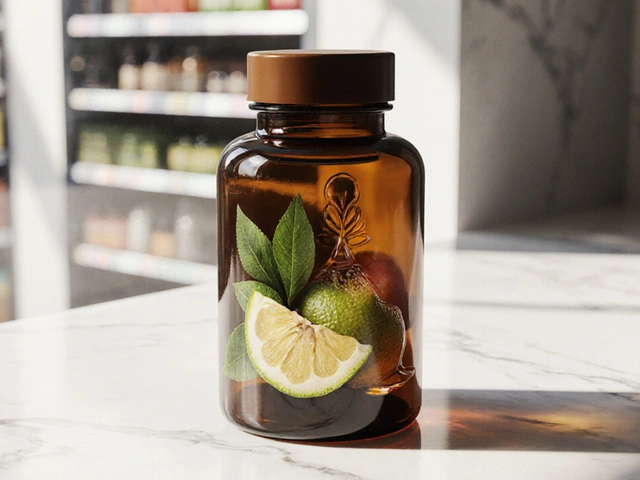
What if the secret to everyday energy, sharper focus, and a happier gut was sitting quietly on the supermarket shelf? Fermented wheat germ extract (FWGE) isn’t some fringe health fad—it’s the supplement wellness experts have been quietly buzzing about. In a world full of complicated vitamin blends and scary-sounding synthetic additives, this grainy powerhouse stands out for a simple reason: real results, backed by real science. It’s not just for hardcore athletes or wellness junkies. Busy parents, students under pressure, anyone needing a health reset—everyone is asking about it. Here’s why FWGE is the supplement people can’t stop talking about.
What Exactly Is Fermented Wheat Germ Extract?
Don’t let the bland name fool you—fermented wheat germ extract packs way more punch than it sounds. At its core, wheat germ is the nutrient-rich embryo of the wheat kernel, that tiny part brimming with vitamins, minerals, and antioxidants. Scientists figured out that if you take this germ and ferment it using baker’s yeast (the same kind found in your bread), you unlock bioactive compounds that aren’t found in plain wheat germ. These include powerful benzoquinones—think of them as molecular superheroes for your cells.
That’s the magic of fermentation. During this process, enzymes and good bacteria break down the wheat germ into smaller, more useful bits. Suddenly, the nutrients become easier for your body to absorb and more potent, too. Think of fermentation like a secret kitchen hack for nature’s original superfood. You’re getting higher concentrations of compounds like spermidine, methylated benzoquinones, and glutathione—names that might sound straight out of a chemistry book, but each one plays a key role in keeping inflammation low and defending your cells from stress and daily wear-and-tear.
Worried about gluten? Don’t be. The fermentation process actually reduces gluten content to trace levels, making FWGE a possible option even for many people with gluten sensitivity. That said, check labels or ask your doctor if you’re celiac, since sensitive folks might still react.
FWGE isn’t a newcomer, either. It was originally developed in Hungary in the 1990s, with the first major studies published around 2002. Hungarian oncologists were curious about why some people bounced back from harsh treatments faster than others. That curiosity led to research on wheat germ fermentation’s ability to boost energy and support the immune system. It’s safe to say the results turned heads far beyond Europe.
Fast forward to today: FWGE is found in capsules, drink powders, and even a few snack bars. If you glance at your health aisle, one of the most popular brands is Avemar, but you’ll see others too, especially at specialty health stores. Unlike many supplements that hype empty promises, FWGE has real human studies to back up its safety and potential effects. No gold-plated nonsense, just a science-based supplement that still flies under the radar in lots of places.
The Science: What Makes FWGE Stand Out?
When you look for a supplement, you want something more than just glossy labels or celebrity endorsements. The real question: does it actually do anything? In FWGE’s case, the answer comes from lab benches and medical journals—not internet trends. Scientists have been poking, prodding, and analyzing this extract for decades, and the findings are fascinating.
First, FWGE contains a unique group of molecules called 2,6-dimethoxybenzoquinone and 2-methoxybenzoquinone. These little guys are known for helping your body manage abnormal metabolic activity—which is basically how your cells work under stress, aging, or even during illness. Studies from the Hungarian Academy of Sciences found FWGE could help cells regulate their energy use more efficiently, making it popular among people looking for clean energy without the jitters of caffeine.
But there’s more. One of FWGE’s superpowers is immune support. Research published in nutrascience journals and even peer-reviewed cancer trials shows that regular use helps support the activity of ‘natural killer’ cells and T-cells—those are the immune system’s front-line fighters. Some early Hungarian studies on people with immune-compromising chronic illnesses reported less fatigue, better appetite, and improved wellbeing compared to placebo groups. That’s rare in the supplement world where ‘proof’ is often fuzzy at best.
Need more specifics? A 2015 review published by Dr. László Hidvégi, who helped invent FWGE, described how users saw a 20% reduction in self-reported fatigue levels after just eight weeks. Another randomized Italian trial in 2017 followed 45 adults with weak immune response and found significantly improved immune marker levels after a month of daily use compared to a control group.
And then there’s the gut-brain link. It turns out, some compounds in FWGE act as prebiotics, meaning they help feed the good bacteria in your gut. You know that phrase ‘healthy gut, healthy mind’? That’s exactly why some users notice better digestion and even a mood boost. The prebiotic effect is gentler than a fiber bomb and can be a game-changer for anyone tired of digestive discomfort or those low-energy slumps that hit after lunch.
Fermented wheat germ extract works differently from most synthetic antioxidants. Instead of trying to force your cells to work harder, it supports the body’s natural balance—almost like a gentle nudge, not a sledgehammer. It’s why so many users say they feel steady, day-long energy rather than rollercoaster highs and crashes.
Here’s a quick look at human study data on FWGE:
| Year | Study Location | Subjects | Main Findings |
|---|---|---|---|
| 2002 | Hungary | 92 adults w/ low immunity | Notable immune function improvements, less fatigue vs. placebo |
| 2015 | Italy | 45 adults (randomized) | 20% lower fatigue scores, improved immune markers in FWGE group |
| 2019 | Germany | Healthy students | Better focus during exams, gentle improvement in mood |
Of course, supplements aren’t magic bullets. But the consistency of the evidence—across ages, lifestyles, and even different health concerns—puts FWGE in a unique league.

Everyday Benefits of Adding FWGE to Your Diet
If you’re picturing some bland, cardboard-tasting wheat cereal, think again. FWGE is usually tasteless, and because you can get it as a powder or capsule, it’s fuss-free to add into real life. Let’s talk about what it can do for you, beyond what the science says.
1. Sustainable Energy: FWGE’s natural blend gives you a different kind of buzz—calm focus that lasts through work, school, or workouts. Unlike sugary drinks or coffee, there are no mid-afternoon crashes or feeling wired then wiped.
2. Immune Support: FWGE feels like a safety net for your immune system. If you work with kids (hello, germ magnets), travel a lot, or just want an extra layer of defense during flu season, this is the supplement you’ll actually remember to take.
3. Digestive Harmony: Tired of probiotics that cost a fortune? FWGE gives you a gentle gut boost by feeding your natural bacteria. Fewer stomach rumbles, less bloating, and a nice up-tick in regularity—it’s the small shifts that make uncomfortable days bearable.
4. Brain Clarity: FWGE shines most when life piles on the stress. People juggling work, parenting, and everything else notice better focus and resilience. Not a miracle, but a clear nudge—a sharper, steadier mind without jitters or crashes.
5. Aging Gracefully: Some antioxidants act like a firehose, blasting every cell whether you need it or not. FWGE supports the body’s own balance, reducing oxidative stress in a way you actually feel. Younger skin, less tired eyes, and enough energy at the end of the day to want to move, rather than flop.
How do you fit it in? Most people start with about 5-10 grams per day, usually stirred into water or a smoothie. You can sprinkle it into yogurt, blend it with juice, or take a capsule with breakfast. If you’re super sensitive to new foods or have allergies, start slow and check for reactions.
One tip: Take it earlier rather than later. Because FWGE can subtly lift your energy, some people (especially those who rarely drink caffeine) prefer it in the morning. At first, you might not feel much, but within two to three weeks, the steady benefits kick in. It’s the opposite of quick fixes—it’s all about clean, gentle support that sticks.
Who Should Try FWGE—and Who Shouldn’t?
The great news? FWGE is one of the safer supplements around. Unlike high-dose herbal extracts, it’s gentle, with a track record going back decades. But like anything with real effects, it isn’t right for everyone.
If you’re generally healthy and looking for extra immune support, energy, or an easier gut, FWGE is worth a shot. It’s especially helpful for anyone who’s:
- Frequently feeling run-down (think teachers, caregivers, nurses)
- Training for a big sports event or regularly working out
- Recovering from a tough season of colds or the flu
- Managing everyday stress and mental overload
- Interested in clean, plant-based supplements
Where should you be more cautious?
- Folks with celiac disease or severe gluten allergy: Even though FWGE has trace gluten, it’s probably not safe if you’re ultra-sensitive.
- If you’re pregnant or breastfeeding, check with your doctor—no major issues reported, but always play it safe.
- Anyone on immunosuppressant drugs or in active cancer treatment: Talk to your healthcare provider first. FWGE isn’t a drug replacement, and more research is still ongoing about interactions.
Kids and seniors can benefit too, especially for immune and mood support, but stick to lower doses at first and monitor for any changes. If you have any autoimmune conditions—like rheumatoid arthritis or lupus—run it by your health team before adding anything new. Most people tolerate FWGE really well, reporting no side effects, but once in a while there’s mild tummy upset or a skin rash. Those are rare, though, and usually go away if you pause or reduce your intake.
Another tip: avoid taking FWGE with highly acidic juices like grapefruit or super-strong black tea, as these can alter its absorption in your gut. Go for water, herbal teas, or mild smoothies instead. You want to give those good compounds their best shot at action.

Tried-and-True Tips for Getting the Most from FWGE
So, you’re convinced: FWGE sounds like a winner. But how do you actually use it, maximize the effects, and turn it from a hopeful experiment into a real daily habit?
First up, pick a reputable brand. Trace the company’s sourcing—are they using non-GMO wheat? Is their fermentation process standardized and tested? Brands like Avemar, Immunovet, and certain pharmacy lines in Europe run rigorous quality control. You’re looking for clear labeling, third-party test certificates, and honest marketing (watch for miracle cure claims; those are a red flag).
Stick with one format for the first month. Either capsule or powder—don’t mix and match doses or brands while you gauge its effects. Most people take FWGE on an empty stomach, about 30-60 minutes before eating. That gives the active compounds time to get absorbed without interference, although taking it with food is fine if you notice any tummy irritation.
Keep it consistent. The big secret to FWGE’s success isn’t some magical dose or wild stacking routine. It’s daily use, ideally at the same time each morning. Wellness bloggers and users on forums say the difference really kicks in after the first two weeks. If you’re tracking symptoms (energy, sleep, mood), jot down some notes or use a wellness app. That way, you’ll see progress and know if it’s worth continuing.
If you’re blending FWGE into food, don’t cook it. High heat can break down the sensitive bioactive molecules. Sprinkle powder onto yogurt, mix into protein shakes, or stir into a glass of room-temperature water. Some creative users have even baked low-temp granola bars with FWGE, but don’t go over 120°F/50°C when heating.
- Pro tip for families: You can hide FWGE in smoothies for kids or seniors—the flavor disappears under strong fruit or chocolate.
- Traveling? The capsules are a cinch to toss in a pill case or backpack—way easier than messy powders.
- If you’re stacking with other supplements, space them at least 30 minutes apart for best absorption.
For the data lovers: There’s no upper safe limit that’s been firmly established, but stick to 5-10 grams for adults, and 1-3 grams for kids. Going beyond that hasn’t shown extra benefits—and with all things, more isn’t always better.
Now, the million-dollar question: Do you need to take it forever? Probably not. A lot of people use it for 3-6 months at a time, during high-stress seasons or when bouncing back from illness. Listen to your body, cycle off for a while, and see how you feel. That’s smart supplementing without falling for endless routines.
Jasper Arboladura
FWGE is essentially a glorified prebiotic with a Hungarian pedigree and a marketing team that read too much PubMed. The benzoquinone compounds are interesting, but the clinical significance is marginal at best. Most studies are underpowered, single-center, and lack replication. The 20% fatigue reduction? That's self-reported data from a cohort that likely had placebo response bias. Real bioavailability data? Barely any. If you want cellular support, just eat more cruciferous vegetables and sleep seven hours.
Also, calling it 'science-based' while citing a 2002 Hungarian study is like citing a 1998 blog post as peer-reviewed. The field needs better controls, not more supplement hype.
And yes, I've read the Hidvégi papers. The methodology was charmingly archaic.
Joanne Beriña
Oh wow, another foreign supplement trying to sell us on 'ancient wisdom' while American companies make real medicine. You know what's really science-backed? FDA-approved drugs, not some fermented wheat sludge from Budapest. We've got biotech labs in Boston and San Diego that could make this obsolete in a year. Why are we still talking about this? It's like buying a horse-drawn carriage because it's 'natural.'
Also, if you're too lazy to get real nutrition from food, maybe you should stop scrolling and go for a walk. This isn't wellness-it's spiritual capitalism.
ABHISHEK NAHARIA
One must consider the ontological framework of this extract within the context of post-industrial nutraceutical capitalism. The fermentation process, while technologically primitive, symbolizes a return to pre-modern epistemic modes of alimentary engagement. Yet, the reductionist framing of 'immune support' and 'gut-brain axis' betrays a Cartesian bias inherent in Western biomedical paradigms.
The Hungarian studies, while methodologically quaint, do point toward a deeper phenomenological truth: that the body is not a machine to be optimized, but a field of subtle energies requiring harmonic resonance. One wonders whether the benzoquinones are merely biochemical intermediates-or perhaps carriers of a vibrational signature lost in industrial processing.
Moreover, the commercialization of FWGE through capsules and snack bars reflects the commodification of ancestral wisdom. The true power of wheat germ lies not in its molecular composition, but in its ritualistic use-ground by hand, fermented under moonlight, consumed with gratitude. The modern user, glued to their screen, has forgotten this.
Therefore, the question is not whether FWGE works-but whether we are worthy of its grace.
Hardik Malhan
FWGE bioavailability is contingent on the fermentation profile and the strain of saccharomyces cerevisiae used. Most commercial products don't disclose the fermentation kinetics or the metabolite profile post-fermentation. Without HPLC-MS validation, you're just ingesting a carbohydrate matrix with trace phenolics.
Also, the gluten reduction claim is misleading. Trace doesn't mean zero. For non-celiacs it's fine. For sensitive folks? You're rolling the dice. I've seen IgE-mediated reactions to fermented grain derivatives before. Don't assume safety based on marketing.
And yes, the prebiotic effect is real but weak. Compared to inulin or FOS, FWGE is a low-yield substrate. You're better off with a banana and a spoon of chia.
Casey Nicole
Okay but like… I tried it for 3 weeks and my skin cleared up and I didn’t cry during Zoom meetings anymore? I don’t care if it’s Hungarian or whatever I just know I felt like a human again after being a zombie for 5 years. I’m not a scientist I’m just a mom who needs to stop feeling like she’s running on fumes.
Also why is everyone so obsessed with debunking things? Can’t we just be happy for one thing that doesn’t give us heart palpitations?
Also also I mixed it in my chocolate protein shake and it tasted like dirt but I did it for my soul and I’m not sorry.
Kelsey Worth
so i tried fwge because my friend said it ‘fixed her gut’ and honestly i feel like i’m a slightly less angry version of myself? like i still have bad days but the 3pm slump is gone and i didn’t have to drink 5 espressos to get through a meeting.
also the packaging looked like it was designed by a 1990s alt-rock band so i’m into it. not a scientist but also not a fool. if it works and doesn’t kill me, why not? the world is on fire and i’m just trying to not cry while folding laundry.
shelly roche
Hey everyone-just wanted to say I’ve been taking FWGE for 4 months now and I’m so grateful I found it. As a nurse working 12-hour shifts, I was running on caffeine and anxiety. This didn’t give me a rush, but it gave me *stability*. My digestion improved, I stopped getting sick every other month, and I actually sleep through the night now.
To the people doubting it: I get it. Supplements are a minefield. But this one didn’t promise miracles-it just quietly showed up. And sometimes that’s all we need.
If you’re curious, start with a capsule a day. Don’t overthink it. Listen to your body. And if you feel better? That’s the real science.
Also, you can find affordable brands on Amazon now. Just check the label for ‘non-GMO’ and ‘fermented with Saccharomyces cerevisiae.’ That’s the gold standard.
Nirmal Jaysval
bro this is just wheat germ with yeast on it and you’re acting like it’s the holy grail. i saw a guy in delhi selling this as ‘ancient vedic energy booster’ for 2000 rupees. he had a chart of chakras next to the bottle.
also the hungarian study? they used 92 people in 2002. i could do better with a spreadsheet and a coffee machine.
and dont even get me started on the gluten thing. wheat germ is wheat. you cant ferment away the protein. you’re just giving your gut a chance to scream.
save your money. eat dal. sleep. walk. stop buying magic dust.
Emily Rose
Shelly here-I just want to say thank you to everyone who shared their experience. It’s easy to get lost in the noise of science vs. hype, but the real stories-like the mom who felt human again or the nurse who slept through the night-are what matter.
To Jasper: your skepticism is valid. The science is limited, yes. But science doesn’t always capture lived experience. Maybe FWGE isn’t a miracle, but for some people, it’s a bridge.
To Nirmal: I hear you. Dal is better than any supplement. But not everyone has access to fresh, balanced meals daily. For someone working two jobs and raising kids, a little help isn’t weakness-it’s survival.
Let’s not tear each other down. Let’s just say: if it helps, and it doesn’t hurt, why not try it? And if it doesn’t? No shame in walking away.
And to Joanne-yes, we have amazing biotech here. But sometimes, the quietest solutions are the ones that’ve been around for centuries. Maybe we don’t need to reinvent the wheel. Maybe we just need to remember how to ride it.





Write a comment